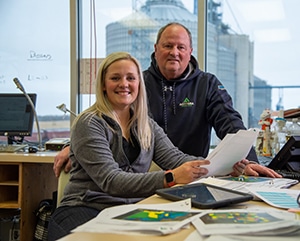Jeff Lakner, his wife Myrna, and their son, Drew and his wife Marisa, operate Lakner Farms LLC, a fifth generation, 4,500-acre arm that includes row crops, hay and pasture near Wessington, South Dakota. They use a three-year corn, soybean and wheat rotation to help keep the soil healthy. Their diversified farm also includes a 400-head commercial Angus-cross cow/calf operation.
Soil variability makes growing crops in the region a challenge and Lakner’s property includes considerable variability within each field. Rather than slowing progress, it has sped their adoption of top-flight crop, soil and nutrient management practices. In fact, they’re adopting variable-rate starter fertilizer in 2022.
“When we mapped 100 percent of our cropland, we implemented the management zone based (MZB) proprietary system that is now part of FieldReveal,” Jeff says. “By identifying 10 to 12 management zones in each 160-acre tract, we focused on targeting optimal inputs on the three to four zones that were most economically viable.
“Dual-hybrid planting lets us select precise hybrids for each zone. Plus, variable-rate seeding and variable-rate fertilizer application gives each plant the best opportunity to express its potential while minimizing input costs,” Jeff adds. “We’ve seen substantial yield improvement by maximizing inputs on targeted acres and by reducing costs in the entire field with precise applications.”
Using the MZB approach helps maintain immobile nutrients such as zinc to within 0.25 ppm of a 1.25 ppm goal across the entire farm. Building organic matter in the region can be challenging, so the Lakners have incorporated no-till with some strip-till for 30 years.
“Along with cover crops, targeted fertilizer applications and integrated livestock grazing, we’re confident we’re promoting soil health,” Jeff says.
Jeff, Drew and Payton Eagle, an Agtegra Cooperative agronomist, make decisions as a team. Jeff notes that Agtegra’s size and scale lets them consider crop protection and fertilizer inclusively. They consider the infrastructure, test plot capacity and human capital resources Agterra offers and pricing, then act on a complete package.
“Our decision process is highly analytical,” Eagle says. “We run numbers and review a lot of yield data to make sure our decisions are right. Plus, MZB is a big factor that helps us get soil sample results and look at zone maps. We keep soil samples up to date within two years so they’re as relative as possible.”
This diligence in following 4R practices shows. Jeff says variable-rate seeding and fertilizer applications accounts for approximately eight to 12 percent in cost savings on inputs and probably more on the marginal soils. Yields prove it, too. Prior to 2019, corn yields were 10 to15 bu/ac higher than comparable fields in the area. Soybean yields averaged incrementally better, as well.
“For our trends, we’re seeing a cost savings on corn of $25 to $40/ac with an accompanying yield increase or 10 to 15 bu/ac,” Jeff says. “Fertilizer cost savings have run about $15 to $30 per acre.”
Best Practice Management
- Use satellite mapping to help identify yield potential and nutrient management plan
- GPS precision nutrient application
- GPS precision planting
- In-season plan tissue testing to evaluate effectiveness of fertilizer program and as a diagnostic tool when needed
- Variable-rate nutrient application across the farm
